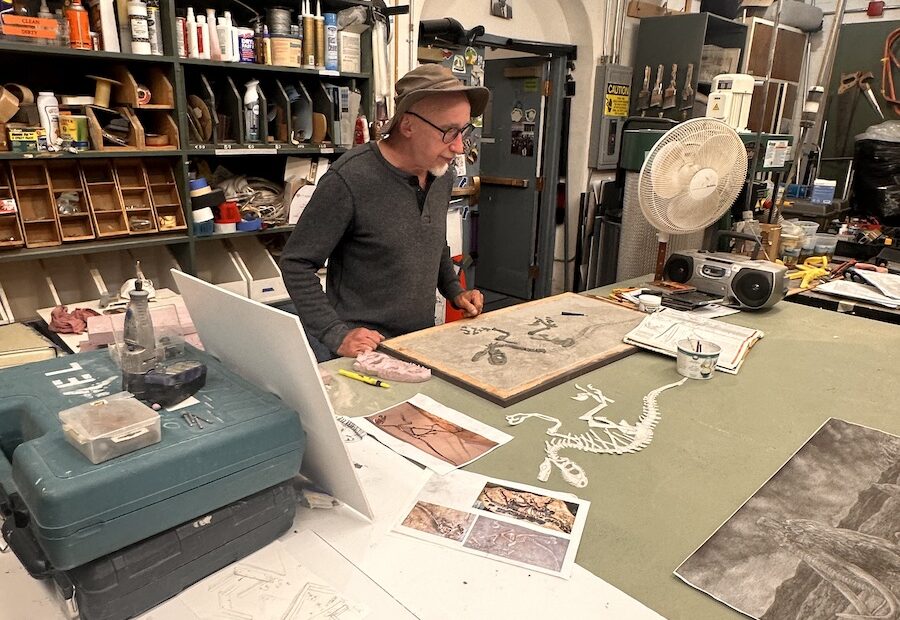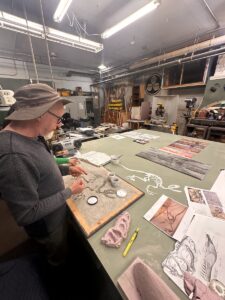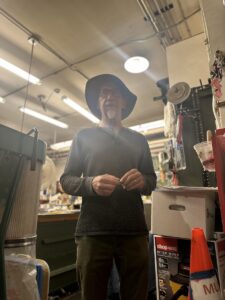
Art and science on display from the man behind the curtain
Listen
(Runtime 3:45)
Read
In a big, open room in the basement of Bellingham’s old city hall, little cupboards line the walls holding spray paint, different kinds of tape, cans of WD-40, and at least four different handheld drills.
Wearing round-framed glasses and an explorer’s hat, museum preparator David Miller stands over the work table, messy with progress. He is sculpting fake dinosaur bones. They will be hidden in a box and covered with sand for children to posture as paleontologists, uncovering the creatures of the prehistoric past.
The interactive sculpture will go in an exhibit, the museum’s latest, that showcases the work of a well-practiced and well-published scientific illustrator — Miller himself.

Miller is working on a sculpture of dinosaur bones that will be hidden under sand, for museum visitors to uncover. (Credit: Lauren Gallup / NWPB)
“Usually David’s work is commissioned by scientists or paleontologists and museums to serve as illustrations for the fossils,” said Amy Chaloupka, the curator who, along with Miller and the museum’s executive director, came up with the idea for the exhibit. “This exhibition is really flipped in that way, where we’re really highlighting David’s work and the fossils are in service to illustrate his paintings.”
Chaloupka, like many who surround Miller, has a true appreciation for his work.
But without Miller’s thoughtful planning and dream of an exhibition of his own, the exhibit would never have come together.
For years, Miller would paint and draw large originals for commissioned pieces. He would scan the original to be reprinted and reproduced. The images are used in textbooks or displayed next to fossils in museums. He always hung on to the originals, sometimes adding to them after and storing them in a closet at home.
“I said, ‘One day I shall have a show,’ This is back in ‘96,” Miller said. “‘I shall have a show one day!’”After a pause, Miller said, “All right, the long game.”
The long game, indeed. The exhibition, UNEARTHED Art & Science Survey the Fossil Record, is filled with more than 60 of Miller’s rich, lifelike paintings. They’re paired with fossils on loan from Burke Museum and the Rice Northwest Museum of Rocks and Minerals, and some from Miller’s personal collection.
The new exhibit begins with one of Miller’s recent works. It’s a painting of woolly mammoths commissioned after the Whatcom Museum was given a woolly mammoth molar. The exhibition is the first time the molar is on display to the public.
As he often does for commissioned pieces, Miller worked with a scientist to get the painting as accurate as possible.
Camilo Ponton is an assistant professor of geology at Western Washington University. Ponton and Miller worked together to dig up information on the behavioral patterns of woolly mammoths.
“The challenge with a fossil is that you only have remnants of some hard body part,” Ponton said. “You don’t know what’s the color of their hair, their pelt … There’s a lot of challenges in artistic illustrations of past extinct creatures because of the lack of information, especially of color and some things that are very visual to us.”
With Miller, Ponton looked at the anatomy of the animal, hair that had been preserved and teeth enamel studies that showed where these animals would have roamed. These puzzle pieces helped Miller create the realistic painting of mammoths in a herd, walking through grasses in what we now consider Alaska, amidst a sunset.
“It’s challenging because in some end, you don’t want to limit the artistic creativity,” Ponton said. “We’re very visual creatures and this is what we’re doing, we’re producing a visual representation and then you have to try to double check facts or what we know and what we don’t know. And in areas where we don’t really know, I think the artists have the upper hand and they could decide that they want to depict the creature in this way or that way.”
As Miller showed the process, he explained how imagination is a part of scientific illustration. Sometimes, visual details like color or the proportions of an animal have to be made up. That invention comes from facts, though. Ponton said Miller is incredibly thorough in his research.
“David has a deep knowledge for a lot of this science, just from this perspective, the processes that he has gone through,” Chaloupka said.
Ever modest, Miller is quick to add, “Kind of by osmosis. I’m not a scientist. They send me all these manuscripts, I gotta read them. It’s like, I’m learning despite myself.”

Miller at the doorway into his workshop, that he shares with other museum employees. (Credit: Lauren Gallup / NWPB)
He’s able to turn science into something plausible and beautiful.
“I used to draw the human figure a lot and I got to the point where I could kind of invent a plausible human figure from just out of the imagination,” Miller said. “So, that really served well as a kind of a learning tool.”
He said he uses physical things he can find to help support his creative process, like a cut-open chicken drumstick from the grocery store to imagine lifelike bones and veins.
Miller’s long and successful career has seen his work displayed in the Smithsonian and Yale. He said it started from a childhood fascination with dinosaurs. He said he once drew a number of prehistoric creatures to don the walls of the elementary school library where his mom worked.
At the end of the interview, Miller focuses back in on finishing the dinosaur sculpture, a possible spark of inspiration for the next generation of scientists, paleontologists and artists.
















